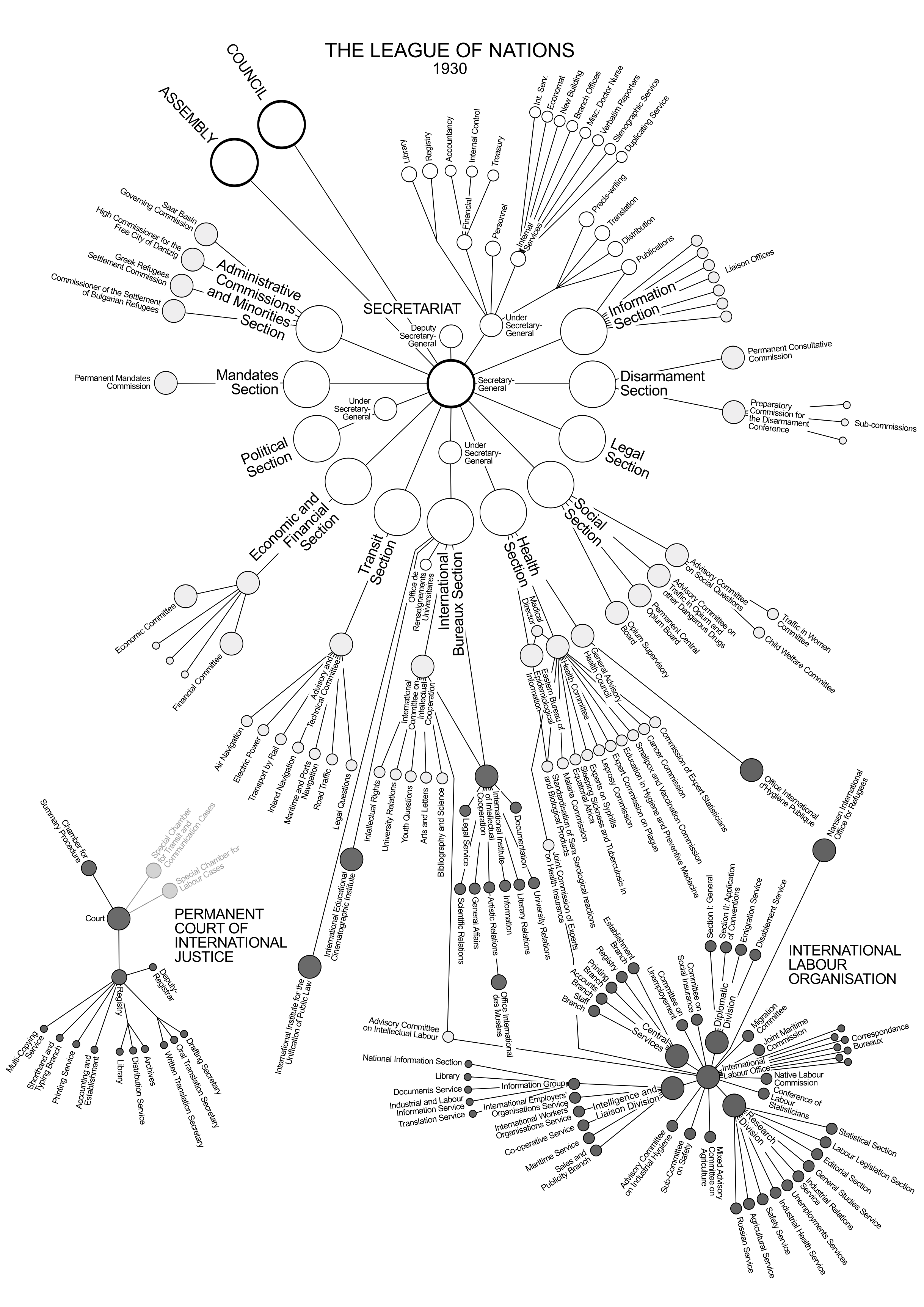|
Organizational Structure
An organizational structure defines how activities such as task allocation, coordination, and supervision are directed toward the achievement of organizational aims. Organizational structure affects organizational action and provides the foundation on which standard operating procedures and routines rest. It determines which individuals get to participate in which decision-making processes, and thus to what extent their views shape the organization's actions.Jacobides., M. G. (2007). The inherent limits of organizational structure and the unfulfilled role of hierarchy: Lessons from a near-war. Organization Science, 18, 3, 455-477. Organizational structure can also be considered as the viewing glass or perspective through which individuals see their organization and its environment. Organizations are a variant of clustered entities. An organization can be structured in many different ways, depending on its objectives. The structure of an organization will determine the modes in ... [...More Info...] [...Related Items...] OR: [Wikipedia] [Google] [Baidu] |
Task Allocation
Task management is the process of managing a Task (project management), task through its life cycle. It involves planning, testing, tracking, and reporting. Task management can help either individual achieve goals, or groups of individuals collaborate and share knowledge for the accomplishment of collective goals.Maus, Heiko, M.P. van der Aalst, Wil, Rickayzen, Alan, Riss, Uwe. V. “Challenges for Business Processes and Task Management,” Journal of Universal Knowledge Management. Volume 0, Issue 2, 2005. Tasks are also differentiated by complexity, from low to high. Effective task management requires managing all aspects of a task, including its status, priority, time, human and financial resources assignments, recurrence, dependency (project management), dependency, notifications and so on. These can be lumped together broadly into the basic activities of task management. Managing multiple individuals or team tasks may be assisted by specialized software, for example workfl ... [...More Info...] [...Related Items...] OR: [Wikipedia] [Google] [Baidu] |
Matrix Management
Matrix management is an organizational structure in which some individuals report to more than one supervisor or leader–relationships described as solid line or dotted line reporting. More broadly, it may also describe the management of cross-functional, cross-business groups and other work models that do not maintain strict vertical business units or silos grouped by function and geography. Matrix management, developed in U.S. aerospace in the 1950s, achieved wider adoption in the 1970s. Overview There are different types of matrix management, including ''strong'', ''weak'', and ''balanced'', and there are hybrids between functional grouping and divisional or product structuring. For example, by having staff in an engineering group who have marketing skills and who report to both the engineering and the marketing hierarchy, an engineering-oriented company produced "many ground-breaking computer systems." This is an example of ''cross-functional'' matrix management, and is ... [...More Info...] [...Related Items...] OR: [Wikipedia] [Google] [Baidu] |
Matrix Management
Matrix management is an organizational structure in which some individuals report to more than one supervisor or leader–relationships described as solid line or dotted line reporting. More broadly, it may also describe the management of cross-functional, cross-business groups and other work models that do not maintain strict vertical business units or silos grouped by function and geography. Matrix management, developed in U.S. aerospace in the 1950s, achieved wider adoption in the 1970s. Overview There are different types of matrix management, including ''strong'', ''weak'', and ''balanced'', and there are hybrids between functional grouping and divisional or product structuring. For example, by having staff in an engineering group who have marketing skills and who report to both the engineering and the marketing hierarchy, an engineering-oriented company produced "many ground-breaking computer systems." This is an example of ''cross-functional'' matrix management, and is ... [...More Info...] [...Related Items...] OR: [Wikipedia] [Google] [Baidu] |
Functional Organization
Functional organization is a type of organizational structure that uses the principle of specialization based on function or role. It allows decisions to be decentralized since issues are delegated to specialized persons or units, leaving them the responsibility of implementing, evaluating, or controlling the given procedures or goals. See also * Departmentalization * Organization design Organizational architecture has two very different meanings. In one sense it literally refers to the organization's built environment and in another sense it refers to architecture metaphorically, as a structure which fleshes out the organizatio ... Types of organization {{org-stub ... [...More Info...] [...Related Items...] OR: [Wikipedia] [Google] [Baidu] |
Marketing
Marketing is the process of exploring, creating, and delivering value to meet the needs of a target market in terms of goods and services; potentially including selection of a target audience; selection of certain attributes or themes to emphasize in advertising; operation of advertising campaigns; attendance at trade shows and public events; design of products and packaging attractive to buyers; defining the terms of sale, such as price, discounts, warranty, and return policy; product placement in media or with people believed to influence the buying habits of others; agreements with retailers, wholesale distributors, or resellers; and attempts to create awareness of, loyalty to, and positive feelings about a brand. Marketing is typically done by the seller, typically a retailer or manufacturer. Sometimes tasks are contracted to a dedicated marketing firm or advertising agency. More rarely, a trade association or government agency (such as the Agricultural Marketing Serv ... [...More Info...] [...Related Items...] OR: [Wikipedia] [Google] [Baidu] |
Complexity Theory And Organizations
Complexity theory and organizations, also called complexity strategy or complex adaptive organizations, is the use of the study of complexity systems in the field of strategic management and organizational studies. It draws from research in the natural sciences that examines uncertainty and non-linearity. Complexity theory emphasizes interactions and the accompanying feedback loops that constantly change systems. While it proposes that systems are unpredictable, they are also constrained by order-generating rules. Complexity theory has been used in the fields of strategic management and organizational studies. Application areas include understanding how organizations or firms adapt to their environments and how they cope with conditions of uncertainty. Organizations have complex structures in that they are dynamic networks of interactions, and their relationships are not aggregations of the individual static entities. They are adaptive; in that, the individual and collective b ... [...More Info...] [...Related Items...] OR: [Wikipedia] [Google] [Baidu] |
Oppression
Oppression is malicious or unjust treatment or exercise of power, often under the guise of governmental authority or cultural opprobrium. Oppression may be overt or covert, depending on how it is practiced. Oppression refers to discrimination when the injustice does not target and may not directly afflict everyone in society but instead targets or disproportionately impacts specific groups of people. No universally accepted model or terminology has yet emerged to describe oppression in its entirety, although some scholars cite evidence of different types of oppression, such as social oppression, cultural, political, religious/belief, institutional oppression, and economic oppression. The Universal Declaration of Human Rights offers a benchmark from which to assess both individual and structural models of oppression. The concept, popularized in Marx and Engels' Communist Manifesto of 1848, is often used to justify state persecution. Authoritarian oppression The word '' ... [...More Info...] [...Related Items...] OR: [Wikipedia] [Google] [Baidu] |
Empowerment
Empowerment is the degree of autonomy and self-determination in people and in communities. This enables them to represent their interests in a responsible and self-determined way, acting on their own authority. It is the process of becoming stronger and more confident, especially in controlling one's life and claiming one's rights. Empowerment as action refers both to the process of self-empowerment and to professional support of people, which enables them to overcome their sense of powerlessness and lack of influence, and to recognize and use their resources. As a term, empowerment originates from American community psychology and is associated with the social scientist Julian Rappaport (1981). However, the roots of empowerment theory extend further into history and are linked to Marxist sociological theory. These sociological ideas have continued to be developed and refined through Neo-Marxist Theory (also known as Critical Theory). In social work, empowerment forms a practica ... [...More Info...] [...Related Items...] OR: [Wikipedia] [Google] [Baidu] |
Participation (decision Making)
Citizen Participation or Public Participation in social science refers to different mechanisms for the public to express opinions—and ideally exert influence—regarding political, economic, management or other social decisions. Participatory decision-making can take place along any realm of human social activity, including economic (i.e. participatory economics), political (i.e. participatory democracy or parpolity), management (i.e. participatory management), cultural (i.e. polyculturalism) or familial (i.e. feminism). For well-informed participation to occur, it is argued that some version of transparency, e.g. radical transparency, is necessary but not sufficient. It has also been argued that those most affected by a decision should have the most say while those that are least affected should have the least say in a topic. Classifying participation Sherry Arnstein discusses eight types of participation in ''A Ladder of Citizen Participation'' (1969). Often ter ... [...More Info...] [...Related Items...] OR: [Wikipedia] [Google] [Baidu] |
Community Organization
Community organization or Community Based Organization refers to organization aimed at making desired improvements to a community's social health, well-being, and overall functioning. Community organization occurs in geographically, psychosocially, culturally, spiritually, and digitally bounded communities. Community organization includes community work, community projects, community development, community empowerment, community building, and community mobilization. It is a commonly used model for organizing community within community projects, neighborhoods, organizations, voluntary associations, localities, and social networks, which may operate as ways to mobilize around geography, shared space, shared experience, interest, need, and/or concern. Introduction Community organization is differentiated from conflict-oriented community organizing, which focuses on short-term change through appeals to authority (i.e., pressuring established power structures for desired change), by f ... [...More Info...] [...Related Items...] OR: [Wikipedia] [Google] [Baidu] |
Non-profit
A nonprofit organization (NPO) or non-profit organisation, also known as a non-business entity, not-for-profit organization, or nonprofit institution, is a legal entity organized and operated for a collective, public or social benefit, in contrast with an entity that operates as a business aiming to generate a profit for its owners. A nonprofit is subject to the non-distribution constraint: any revenues that exceed expenses must be committed to the organization's purpose, not taken by private parties. An array of organizations are nonprofit, including some political organizations, schools, business associations, churches, social clubs, and consumer cooperatives. Nonprofit entities may seek approval from governments to be tax-exempt, and some may also qualify to receive tax-deductible contributions, but an entity may incorporate as a nonprofit entity without securing tax-exempt status. Key aspects of nonprofits are accountability, trustworthiness, honesty, and openness to eve ... [...More Info...] [...Related Items...] OR: [Wikipedia] [Google] [Baidu] |
Cooperatives
A cooperative (also known as co-operative, co-op, or coop) is "an autonomous association of persons united voluntarily to meet their common economic, social and cultural needs and aspirations through a jointly owned and democratically-controlled enterprise".Statement on the Cooperative Identity. '' International Cooperative Alliance.'' Cooperatives are democratically controlled by their members, with each member having one vote in electing the board of directors. Cooperatives may include: * businesses owned and managed by the people who consume their goods and/or services (a [...More Info...] [...Related Items...] OR: [Wikipedia] [Google] [Baidu] |








